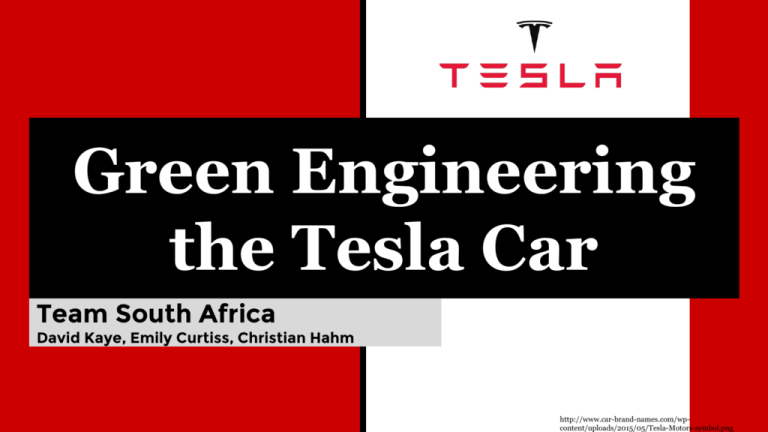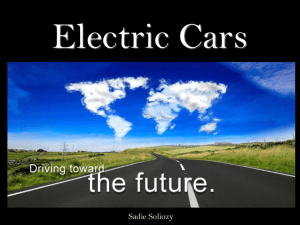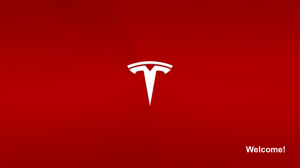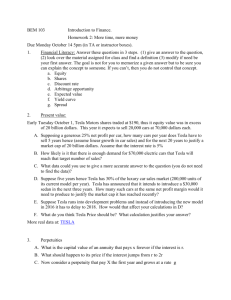Green Engineering – the Tesla Automobile
advertisement

Green Engineering the Tesla Car Team South Africa David Kaye, Emily Curtiss, Christian Hahm http://www.car-brand-names.com/wpcontent/uploads/2015/05/Tesla-Motors-symbol.png The Tesla Automobile (Roadster) What Makes a Tesla Roadster? • “The Gas Tank” - An environmentally non-toxic Lithium-ion battery pack • recyclable to reuse approximately 90% of the materials in the battery cells • can be charged from any wall plug and go from empty to full charge within 4 hours. • “The Engine” - An electric motor • three times more efficient than a regular internal combustion engine • “The Upkeep” - Does not require fluid, belt, and spark plug changes • “The Body” - Carbon fiber body • 30% less mass than a regular steel body. Gluckman, David. “Model S-pinoff: Tesla Planning Model X Crossover for Frankfurt Debut, Coupe and SUV to Follow.” Car and Driver. Feb. 3, 2011. Web. Nov. 3, 2015. The Tesla Automobile (Roadster) • The lithium-ion battery is nearly 50% lighter than a traditional hybrid battery • The cooling system is so efficient that cells on opposite sides of the battery stay within a few degrees of one another • The battery cells were designed with a heating and cooling element so the battery will operate in any condition. "Battery." Roadster Technology. N.p., 26 Jan. 2011. Web. 16 Nov. 2015. PEM-green, Battery-blue, Electric Motor-under the PEM http://www.onelectriccars.com/category/tesla-motors/tesla-roadster/page/2/ Current Materials Dilemma • Graphite is a major component of electric car batteries, and the process of transforming it into a useable product requires large amounts of corrosive materials • This process releases many pollutants into the atmosphere • The Tesla battery cannot properly be reevaluated • There are alternate ways to acquire these materials to lessen their carbon footprint Ingram, Antony. “Tesla Gigafactory Seeks North American Raw Materials To Cut Pollution.” Green Car Reports. Apr. 20, 2014. Web. Nov. 3, 2015. http://s3.amazonaws.com/s3.agoracom.com/public/photos/images/5188/large/26848317.jpg Issues with Current Materials • Incorporating graphite and lithium into the battery is unclean and toxic to the environment • Overseas shipping creates large amounts of emissions and pollution Ingram, Antony. “Tesla Gigafactory Seeks North American Raw Materials To Cut Pollution.” Green Car Reports. Apr. 20, 2014. Web. Nov. 3, 2015. http://www.soleilbank.com/Shipping%20Cargo%20Boat.jpg http://web.mit.edu/urbanupgrading/upgrading/case-examples/ce-PH-ton.html Environmentally Friendly Alternatives The materials used in the production of Tesla Automobiles may be sourced more locally • Lithium can be sourced from Rockwood in Nevada or North Carolina • Cobalt can be sourced from Formation Metals Inc. in Idaho Companies stationed in Canada are also a viable option • Avalon Rare Metals Inc. in Toronto can also provide lithium • Tesla can source its energy from RB Energy, which will soon have a plant in Quebec Ingram, Antony. “Tesla Gigafactory Seeks North American Raw Materials To Cut Pollution.” Green Car Reports. Apr. 20, 2014. Web. Nov. 3, 2015. Issues with Alternatives • Six new graphite mines would be needed to meet the demand that would occur from cutting foreign sources • The cost to purchase these materials would increase drastically • Outsourced materials purchased in high quantities are far less expensive than locally sourced materials Biello, David. “How Tesla Motors Builds One of the World's Safest Cars.” Scientific American. Sept. 23, 2013. Web. Nov. 3, 2015. http://blog.caranddriver.com/model-s-pinoff-tesla-planning-model-x-crossover-for-frankfurt-debut-coupe-and-suv-to-follow/ Sources Gluckman, David. “Model S-pinoff: Tesla Planning Model X Crossover for Frankfurt Debut, Coupe and SUV to Follow.” Car and Driver. Feb. 3, 2011. Web. Nov. 3, 2015. "Battery." Roadster Technology. N.p., 26 Jan. 2011. Web. 16 Nov. 2015. Ingram, Antony. “Tesla Gigafactory Seeks North American Raw Materials To Cut Pollution.” Green Car Reports. Apr. 20, 2014. Web. Nov. 3, 2015. Biello, David. “How Tesla Motors Builds One of the World's Safest Cars.” Scientific American. Sept. 23, 2013. Web. Nov. 3, 2015.





